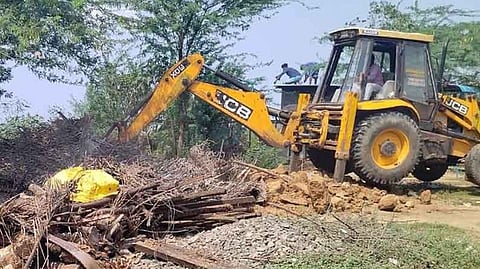

Way back in the early 1950s, when the newly-liberated country was learning the ways of independence and democracy, the largest party, the Indian Nation Congress, had adopted two bulls tied to a yoke as its symbol. In a poor and rural country that was primarily agrarian, it perhaps was the best choice that could at once resonate and represent the masses. Now, about seven decades on, the bulldozer is the symbol of the country – rather its society that is increasingly becoming majoritarian – in more ways than one.
The transformation has been happening for some decades, but surreptitiously, perhaps because of the commonly held belief that India was inherently pluralistic and secular, and would reject any attempt to reshape it into a majoritarian country. However, the change in recent years has been so drastic that bulldozers are not sent in the dead of night but are instead proudly paraded in election rallies and victory marches.
It started in Uttar Pradesh where it was used as a law enforcement tool to demolish the buildings owned by those accused in criminal cases. The boisterous reception that the move received from a large number of people inside and outside the State not only encouraged the UP administration to continue it as a “drive against criminals”, but also prompted other states, all ruled by the BJP, to imitate. The latest was in Assam, where the houses of those accused in attacking a police station were flattened.
It does not take a legal expert to know why such drives are illegal and even unconstitutional. In one instance, three of those accused in a riot in Madhya Pradesh, whose properties were demolished, were already in prison at the time of the riot. Even if some of the accused were indeed part of the crime they are accused of, it still requires a court of law to hear the case and find them guilty. Otherwise, it would turn the dictum ‘innocent until proven guilty’ upside down.
It is easy to blame the politicians for this perversion of the procedure. After all, they are the proponents, practitioners and beneficiaries of the bulldozer innovation. But shorn of the lofty notions of leading the society and country to the future, parliamentary politics is often about pandering to votes to capture power. In that, it is no different from any mass-market product.
In this case, hence, the blame falls on the courts, especially the constitutional courts that have the responsibility to ensure that the constitutional values and norms are not violated by the regimes. In reality, however, the courts have largely failed to play their role. When an advocate moved the Madhya Pradesh High Court against the demolition drive arguing that bulldozing the house of an accused without giving him/her an opportunity to be heard is illegal, the bench dismissed the public interest litigation stating that there was no public interest involved and added that any of the affected parties may instead file a plea.
Bulldozing the properties of an accused person is no different from ‘encounter killings’ where the accused are gunned down before their guilt is established through due process. Both fall under the same category commonly referred to as instant justice, a misnomer because such actions are never just. The Supreme Court should step in to put breaks on the drive, failing which the concept of rule of law, the cornerstone of democracy, will cease to have any meaning.
Are you in Chennai? Then click here to get our newspaper at your doorstep!
Visit news.dtnext.in to explore our interactive epaper!
Download the DT Next app for more exciting features!
Click here for iOS
Click here for Android